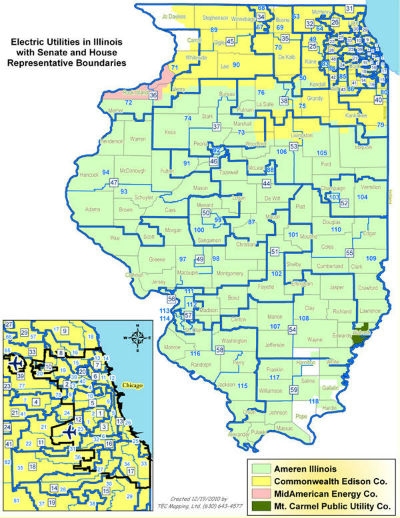Illinois Electricity and Gas Market Liberalization
Since 1997, Illinois began to open the electricity and natural gas retail markets. But why was this process initiated and what impact has it had on the lives of Illinois residents?
What is Electricity and Gas Liberalization?
In the United States, traditional gas and electricity suppliers have defined service areas. Utilities are able to deliver energy only within fixed boundaries, with no overlap. In states where the market isn’t fully open to competition, a consumer’s location can determine their only choice for an electricity or gas supplier.
With 1997 energy legislation, Illinois began to gradually open up the electricity and gas markets to competition. Since about 2008, many Illinois customers have had real opportunity to choose their suppliers – and profit from big savings. Savings can be staggering, and over 70% of residential consumers in Illinois already get their electricity from an alternative supplier, according to EnergyWire.
How does Liberalization Work?
With healthy competition in the energy sector, consumers and business owners in Illinois have the benefit of choosing the supplier that best meets their needs, whether in the form of savings or more environmentally-friendly energy. It’s simple – with over 40 alternative and traditional electricity and gas suppliers in Illinois, each one must compete on price and other metrics to the benefit of the consumer.
Electricity Deregulation
Alternative Electricity Suppliers (AES) are available for customers in Commonwealth Edison and Ameren service areas.

la légende
Illinois service map of electricity utility companies
AES purchase their energy from one of these two main suppliers and then deliver it to consumers at their own rate. Others generate their own. While ComEd and Ameren take care of distributing the electricity across power lines, consumers interact with and pay alternative suppliers directly.
Gas Market Deregulation
The Illinois gas market has undergone liberalization, as well. Under the Natural Gas Choice program, consumers and businesses located in Nicor Gas, North Shore Gas, and Peoples Gas service areas are free to seek out an Alternative Gas Supplier (AGS). As with electricity, natural gas is still delivered by the traditional supplier even if you switch to an alternative supplier.
Although gas liberalization has taken off a little more slowly than the market for alternative electricity supply, there are already 300,000 residents in Illinois who have changed to an Alternative Gas Supplier, out of about 4.5 million households, according to the Illinois Competitive Energy Association.
What Are Some of the Benefits of Electricity and Gas Market Liberalization?
Because of energy competition, consumers can switch to whichever electricity supplier offers the most affordable option. Savings can be significant, and according to Greg Baise, President and CEO of the Illinois Manufacturer’s Association, businesses in the state of Illinois have already saved up to a billion US dollars thanks to being able to choose their energy supplier. Additionally, Illinois residents are free to find an electricity or gas supplier that offers green energy options.
Which Communities Can Benefit?
Illinois is still in the process of liberalizing its gas and electricity markets. For the time being, only consumers living in Commonwealth Edison and Ameren service areas have the option of switching to an Alternative Retail Electric Supplier. Customers served by MidAmerican Energy and Mt. Carmel Public Utility are also allowed to switch providers, but no Alternative Retail Electric Suppliers have yet registered to provide their service territories, according to PlugIn Illinois.
Gas customers also may switch to an Alternative Gas Supplier only if they live within Nicor Gas, North Shore Gas, or Peoples Gas service territory.
Government-Negotiated Energy Prices – Municipal Aggregation

Depending on your location, your municipality may already have begun a municipal aggregation scheme, where officials negotiate with energy suppliers to deliver lower prices to the community as a whole. Though most commonly electricity schemes, some cities including Chicago have succeeded in negotiating gas and electricity prices, and by also integrating green power options into the mix, Chicago is projected to save nearly 30% on energy costs and significantly reduce energy pollution at the same time.
After an amendment to the Illinois Municipal Power Agency Act gave municipalities the right to bargain on behalf of their constituents, municipal aggregation has taken off in Illinois. The program is great for consumers, as municipalities have a more powerful bargaining position than individuals, and they can also seek out a higher proportion of green energy for the community as a whole.
How Do I Participate?
Most municipalities offer an “opt-out” scheme, which means that enrollment with the newly-negotiated price and retail supplier is automatic for consumers of the municipality. For consumers who prefer to look for other sources of electricity, they can simply opt-out of the program. Other municipalities allow consumers and business owners to “opt-in”, which requires action by inhabitants to enroll.
At this time, Municipal Aggregation schemes in Illinois are only taking place within Commonwealth Edison and Ameren service territories. To see whether your community takes part, consult a complete list of municipalities on the Plug in Illinois website.
More choice; Better Prices
No matter what your community may provide, the state of Illinois allows consumers and business owners to venture out on their own to see what other energy providers have to offer. The bottom line? As a resident of Illinois, you have the opportunity to choose your own gas and electricity suppliers – and choice means savings.